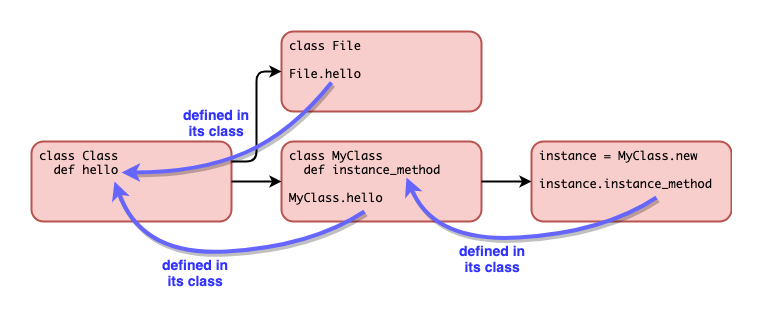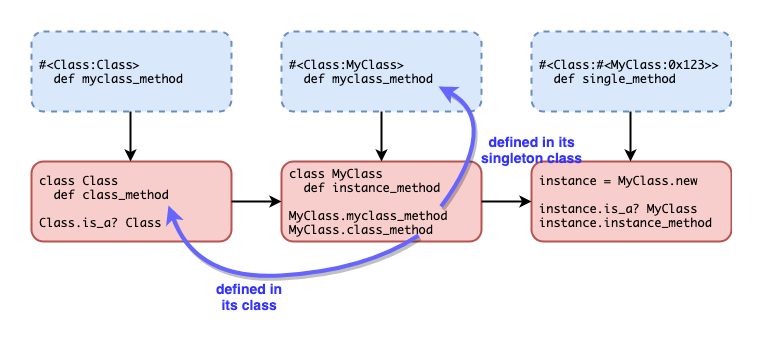Method Madness: Chapter 2
How class methods in Ruby totally explain the "singleton class" thing
It’s happened to many Ruby programmers. Some writing mentions something about a singleton class. You gloss over it, absorbing enough to get done what you need. At some point, you read a blog that totally explained it really well. But a month later, you can’t quite recall the details, and you’re not sure if it matters.
It doesn’t have to be this way. The singleton class may be a bit of a Rubyist’s oddity, but it’s really not that difficult to understand and, importantly, re-derive on command if you get into the Ruby mentality.
Everything is an Object
Everything is a object. That is, everything is an instance of a class. A class is an instance of a class (specifically, the Class class). Let’s really explore what this means. Fire up your ruby interpreter, and let’s use the File class as an example.
File.class
# => Class
File.is_a?(Class)
# => true
If File is an instance of Class, that means a method defined by Class can be called by File.
class Class
def hello
"Hello, class!"
end
end
File.hello
# => "Hello, class!"
File is an instance of Class, but not the only instance. A method defined in Class is available to every instance of Class. In other words, hello is a class method for every class. (Yes, even Class itself.)
class MyClass
end
MyClass.hello
# => "Hello, class!"
Classes define methods available to their instances. Class is no different; it defines methods for its instances, which is all classes. Class methods are just instance methods for instances of Class.

So how do we get a class method for just MyClass? When we define one by putting it on Class, it becomes available to every class ever. No good. We need a place to define the method where it can only be accessed by the single instance MyClass.
That’s where singleton classes come in. Every object in Ruby has a singleton class, which is a class whose only instance is that object. So a method defined on a class’ singleton class is exactly where its class methods can live without affecting other classes.
Class Methods
Class methods in Ruby were always little weird. No mention of “static” methods like in other OOP languages. Instances can’t call class methods. Defining class methods looks strange. But wrapping your head around this method of doing so unlocks the whole puzzle:
class MyClass
def self.class_method
"Some class method"
end
end
Above, self is equal to MyClass. So here’s another way of doing the same thing.
def MyClass.class_method
"Some class method"
end
If you’re familiar enough with Ruby’s oddities, you know that this is a way to define a method only for a single object. In this case, that object is MyClass. Everything is an object.
If you’re not that familiaar with this method of defining methods, it goes like this:
obj1 = MyClass.new
obj2 = MyClass.new
# define the method `whisper` only for obj1, with no relation to obj2 or MyClass
def obj1.whisper
"Shhh"
end
obj1.whisper
# => ""Shhh"
obj2.whisper
# NoMethodError (undefined method `whisper' for #<MyClass:0x00007f886c915900>)
MyClass.new.whisper
# NoMethodError (undefined method `whisper' for #<MyClass:0x00007fddad851aa0>)
In both cases, using def something.method defines a method available only to something. When something is a class, hey presto you have class method.
Methods are defined on classes. On what class is whisper defined such that it applies to just obj1 and not obj2 or any other instance of MyClass? Same question: where does a class method for MyClass live such that it applies only to MyClass and no other instace of Class?
The Singleton Class
The solution to the above is how we arrive at singleton classes. MyClass may be an instance of Class. But it’s also an instance – the singleton instance – of another class called its singleton class.
klass = MyClass.singleton_class
# => #<Class:MyClass>
MyClass.is_a?(klass)
# => true
klass.instance_methods(false)
# => [:class_method]
Notice that class_method is an instance method of klass, making it a class method of MyClass. This is because MyClass is an instance of klass. Everything is an object.
And that’s it – the singleton class is just a place for these methods to live that allow us to have class methods in Ruby under the mandate that every class is an instance of Class.

But wait, this diagram of method lookup seems a little inelegant for Ruby. Keep reading, friend.
Singleton Classes and Inheritance
There’s another critical feature fo singleton classes. If a class gets subclassed, then the singleton class does too. This is how subclasses can call class methods of their parent classes.
class MySubclass < MyClass
end
MySubclass.class_method
# => "Some class method"
For this to happen, MySubClass’s singleton class must be a subclass of MyClass’s singleton class.
s1 = MyClass.singleton_class
# => #<Class:MyClass>
s2 = MySubclass.singleton_class.superclass
# => #<Class:MyClass>
s1.equal?(s2)
# => true
So when an instance object such as obj1 or MySubclass calls a method, it looks up that method definition first from its singleton class* , then from that singleton class’ ancestors.
* – including any included modules
So when does the method lookup chain switch over to start looking for methods in an object’s regular class instead of its singleton class ancestry?
It doesn’t have to. An object’s class is a part of its singleton class ancestry. Let’s print the whole thing out.
klass = MySubclass.singleton_class
while klass do
puts klass
klass = klass.superclass
end
# #<Class:MySubclass>
# #<Class:MyClass>
# #<Class:Object>
# #<Class:BasicObject>
# Class
# Module
# Object
# BasicObject
The key to this working is that BasicObject’s singleton class (#<Class:BasicObject>) is a subclass of Class. So method lookup only follows one rule: start at the singleton class, and walk up the ancestry chain until you’re done.
What about singleton methods of non-Class objects?
obj = MySubclass.new
klass = obj.singleton_class
while klass do
puts klass
klass = klass.superclass
end
# #<Class:#<MySubclass:0x00007f886e927a18>>
# MySubclass
# MyClass
# Object
# BasicObject
obj’s singleton class is a subclass of MySubclass itself. Same logic: obj’s singleton class is a subclass of obj’s class (MySubclass), just as BasicObject’s singleton class is a subclass of BasicObject’s class (Class).
The only difference Ruby would need to be aware of is that when defining a singleton class for an object, its parent class is the objects’s parent class if it has one, or the object’s class if it doesn’t.
So method lookup is dead simple. Start at the singleton class and go up the chain of ancestry. When we call a method on obj, we will eventually look for a definition in MySubclass using this rule, but only after first looking at obj’s singleton class.
A final thought: class « self
You’ll notice I relied on the def MyClass.method way of defining subclasses. You’re likely familiar with another. Armed with our understanding of single classes, let’s put it back on the table.
class MyClass
class << self
def class_method
"Some class method"
end
end
end
Why, yes, it’s the same as this:
class << MyClass
def class_method
"Some class method"
end
end
Just as class MyClass opens up a context for MyClass, class << MyClass opens up a context for its singleton class.
This doesn’t just work on instances of Class, but on any object at all.
class << obj
def obj_method
"Obj!"
end
end
obj.obj_method
# => "Obj!"
In both cases, we’re just defining methods in a singleton class. The exact same rules apply – you can even use calls like attr_reader and include. These are, after all, just methods, and everything, which includes singleton classes, is an object.
That said, it’s immediate code smell to start defining methods on a non-Class instance and using class constructs on its singleton class. Sure, it’s useful for testing and debugging code when you just want to bend objects to your will. Still, I have yet to encounter a single justifiable production-environment use case for handling and modifying a non-Class object’s singleton class.
Oh, right, there was that one time…